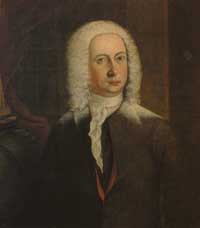James Whatman (papermaker) on:
[Wikipedia]
[Google]
[Amazon]
 James Whatman (1702–1759), the Elder, was a paper maker, born in Kent, who made revolutionary advances to the craft in England. He is noted as the inventor of
James Whatman (1702–1759), the Elder, was a paper maker, born in Kent, who made revolutionary advances to the craft in England. He is noted as the inventor of
 James Whatman (1702–1759), the Elder, was a paper maker, born in Kent, who made revolutionary advances to the craft in England. He is noted as the inventor of
James Whatman (1702–1759), the Elder, was a paper maker, born in Kent, who made revolutionary advances to the craft in England. He is noted as the inventor of wove paper
Wove paper is a type of paper first created centuries ago in the Orient, and subsequently introduced to England, Europe and the American colonies in the mid-eighteenth century. Hand-made wove paper was first produced by using a wooden mould that ...
(or Vélin), an innovation used for high-quality art and printing. The techniques continued to be developed by his son, James Whatman the Younger (1741–1798). At a time when the craft was based in smaller paper mills, his innovations led to the large scale and widespread industrialisation of paper manufacturing.
Life
Whatman was the last child and only son of Mary and James Whatman. His father was a tanner and his son inherited the business in 1726 when his mother died. This Whatman continued the tanning business but in 1733 he was starting to make paper at the Old Mill inHollingbourne
Hollingbourne is a village and civil parish in the borough of Maidstone in Kent, England. The parish is located on the southward slope of the North Downs to the east of the county town, Maidstone. The parish population is around 900 and has th ...
. He assisted James Harris who built a new paper mill there. Harris died in 1739 and Whatman married his widow and gained Harris's business.
This James Whatman had been approached by John Baskerville, who needed paper that would take a light impression of the printing plate; this was used for the edition of Virgil's poetry, embellished with Baskerville's typography and designs. The earliest examples of wove paper, bearing his watermark, appeared after 1740.
This James Whatman and his wife had a child in 1741 who was also named James Whatman and who would later be another innovative paper manufacturer. His wife Susanna Whatman
Susanna Whatman (born Susanna Bosanquet) (23 January 1753 – 29 November 1814) was a British writer on household management who came to notice about 200 years after her birth.
Life
Susannah was born in 1753 in Hamburg. She was the daughter of J ...
would run his house; her writing on household management would come to notice about 200 years later.
The business, in addition to producing the finest paper, is probably responsible for the invention of the wove wire mesh used to mould and align the pulp fibres. This is the principal method used in the mass production
Mass production, also known as flow production or continuous production, is the production of substantial amounts of standardized products in a constant flow, including and especially on assembly lines. Together with job production and batc ...
of most modern paper. The Whatmans held a part interest in the establishment at Turkey Mill
The River Len is a river in Kent, England. It rises at a spring in ''Bluebell Woods'' to the southeast of the village centre of Lenham from the source of the River Great Stour; both rise on the Greensand Ridge. Its length is c. It enters the ...
, near Maidstone, after 1740; this was acquired through the elder Whatman's marriage to Ann Harris.
The "handmade" paper bearing the Whatman's mark was still produced for special editions and art books until 2002.
The company he founded, Whatman plc
Whatman plc is a Cytiva brand specialising in laboratory filtration products and separation technologies.
Whatman products cover a range of laboratory applications that require filtration, sample collection (cards and kits), blotting, lateral f ...
, later specialized in producing filter papers and is now owned by GE Healthcare
GE HealthCare is a subsidiary of American multinational conglomerate General Electric incorporated in New York and headquartered in Chicago, Illinois. As of 2017, it is a manufacturer and distributor of diagnostic imaging agents and radiopharma ...
. Last production at Maidstone (Springfield Mill) was in 2014.
Whatman's name has entered many languages, e.g. the French (''le whatman'') and the Russian, where ватман (''vatman'') is a generic word for heavy high-quality paper used for drawing and watercolors.
See also
*Thomas Balston
Thomas Balston (30 July 1883 – 4 October 1967)Who's Who, 1968-1969, A. & C. Black, 1968, p. 144 was a director of the publishers Duckworth and Co., and a noted scholar of English book production and illustration.1702 births
Papermakers
Papermaking in the United Kingdom
1759 deaths
People from Hollingbourne